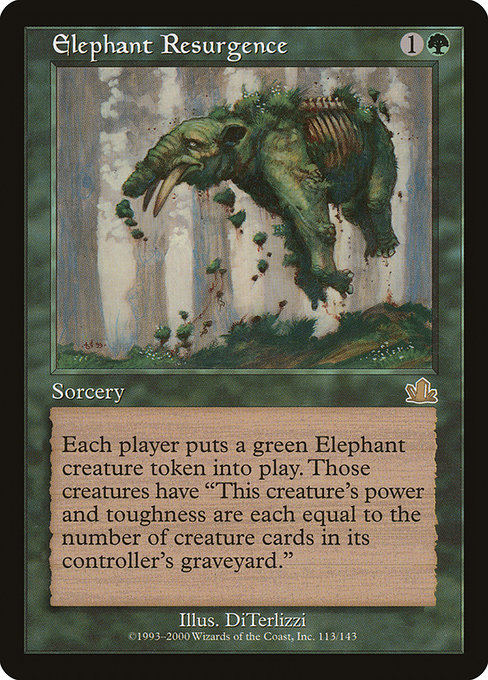
Image courtesy of Scryfall.com
Parody, Memes, and the MTG Community: A Fan Identity in Motion
Magic: The Gathering has always thrived on more than just spells and combos. It thrives on shared jokes, inside humor, and the way a card can become a touchstone for a community’s voice. Parody isn’t merely a wink at mechanics; it’s a social contract that says: we’re in this together, shaping a culture through how we talk about the game. In that light, Elephant Resurgence becomes more than a card text box—it’s a prompt for conversation, fan art, memes, and a playful reminder that the game can be enjoyed on many levels beyond tournament math. 🧙♂️🔥
Elephant Resurgence as a microcosm
Consider the card: a green two-mana sorcery from the Prophecy expansion (set code pcy), illustrated by the legendary DiTerlizzi, and graded rare. The effect is deceptively simple yet thematically rich: “Each player creates a green Elephant creature token. Those creatures have ‘This token’s power and toughness are each equal to the number of creature cards in its controller’s graveyard.’” That line packs humor and strategy in equal measure. You’re not just filling the board with elephants; you’re fashioning a tiny barometer of your own graveyard activity. The more creature cards you’ve sacrificed to the graveyard, the beefier your elephant army grows. It’s a playful inversion of typical “pump your army” goals and a sly nod to the lore of memory and loss—resetting the board with a chorus of arithmetic elephants. The token design is a cute reminder that green loves to multiply brave little creatures, and in this case those creatures are literally copies of your own deck’s history. ⚔️🎨
From a design perspective, Elephant Resurgence represents how green’s strengths—token generation, resilience, and natural growth—can be paired with a twist: a scaling rule that ties power to a non-visible resource (the graveyard). The artifact of the token is both adorable and ominous, a visual joke in the middle of a serious game. The card’s rarity and the two-mana hurdle keep it accessible enough for casual experimentation while still offering a memorable, game-long payoff. Collectors appreciate DiTerlizzi’s art and the Prophecy era’s distinctive flavor, which makes this card a nostalgic wink to players who cut their teeth on late-90s and early-2000s MTG. 💎🧙♀️
Parody as a social practice
Parody in MTG culture isn’t just about roasting a card—it’s about sharing a language. Cards like Elephant Resurgence become launch points for memes, fan-made variants, and art swaps that travel across social spaces and local game stores. The conversation revolves around what it means to observe a card that rewards memory and meta-banter: you draft, you play, you remember, and you laugh together about how a board can swing not just on big spells but on the footprint you’ve left in your graveyard. The elephants themselves symbolize, in a lighthearted way, the community’s memory—every token a tiny echo of a card that once moved a game in a different direction. 🧙♂️💎
Strategic flavor without snobbery
Fan identity in MTG thrives on inclusivity, humor, and curiosity. Parody helps lower the barrier to entry by inviting newcomers to enjoy the culture without feeling left out of in-jokes or deep-cut references. Elephant Resurgence is a perfect example: it invites goofy brews that still respect the game’s rules and the strategic risks of pushing a graveyard-based engine. A casual deck built around this spell becomes a story in itself—a deck that chronicles your game-day journey, with elephants marching forward as a playful ledger of what you’ve seen and what you’ve learned. The balance between lightheartedness and tactical nuance is precisely what keeps the community engaging and welcoming. 🧙♂️⚔️
Aesthetic, art, and collectibility
On the collectibility front, Elephant Resurgence marks a spot in the Prophecy line that fans often revisit with fond nostalgia. The original artwork by DiTerlizzi, combined with the set’s period-style frame, evokes a specific era of MTG that many players remember as a golden age of fantasy illustration. Foil variants remain a draw for collectors, and the card’s price range—roughly a few dollars for nonfoil, rising higher for foil copies—reflects its status as a quirky, beloved artifact rather than a must-have for power-mumping tournaments. The card’s green aura and graveyard-driven theme also resonate with modern greens, where the environment is as much a character as any creature on the battlefield. This connection between art, lore, and play fuels a fan identity that cherishes both the memory and the ongoing evolution of the game. 🎲🎨
For fans who want to bring a little of this culture into daily life, a neon-card aesthetic vibe goes a long way. The Neon Card Holder Phone Case is a cheeky nod to the vibrant energy of MTG communities—a practical, on-the-go gift for deck builders and token crafters alike. If you’re curious about this playful crossover, you’ll find the product link below. 🧙♂️
Neon Card Holder Phone CaseImage courtesy of Scryfall.com
More from our network
- https://crypto-acolytes.xyz/blog/post/best-practices-for-minecraft-gold-farm-a-complete-guide/
- https://crypto-acolytes.xyz/blog/post/how-gitcoin-funds-web3-open-source-projects/
- https://transparent-paper.shop/blog/post/designing-minimalist-wallpapers-with-strong-aesthetic-appeal/
- https://blog.digital-vault.xyz/blog/post/hellfire-power-across-mtg-sets-scaling-insights/
- https://crypto-acolytes.xyz/blog/post/definitive-ranking-of-the-hardest-games-ever-made/